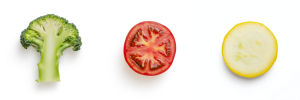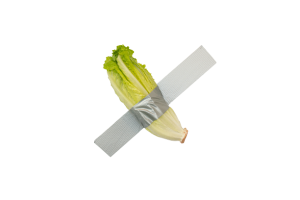You might sometimes feel hungry if you finish your meal even though you have consumed all your macronutrient needs, and the reason for that is your meal doesn’t have enough volume. In this article, I am going to tell you how to increase the size of your meal without increasing the total calories. We will learn about high volume low calorie foods, and their benefits, and we’ll go over a bunch of examples. We will also discuss how to pair them with other foods and show you how some common meals use them to enhance flavor. I used high volume low calorie food in my daily repertoire for the past 5 years and I successfully reduced my total daily caloric consumption, this made me feel full at every meal. I am going to tell you now exactly what are high volume low calorie foods, let’s start.
High volume low calorie food are essentially foods that have low caloric content per weight. This is referred to as nutrient density, and it usually ranges from 20%-70% in these types of foods. They may contain low amounts of calories because most of them contain high amounts of water.

Cashews Vs. Watermelons
Table of Contents
What is Food Volume?
Volume in physics is the measure of three-dimensional space, and it is usually obtained by multiplying the length by the width and the height of an object. The units commonly used to measure it are the cubic meter, cubic centimeters, Liters, and milliliters, with the latter being popular to use with food. food volume is essential because your stomach can take a certain amount of food, and it has special stretch receptors that detect food volume to signal fullness.
What is Nutrient Density?
This brings us to caloric density or nutrient density. nutrient density is simply the amount of calories in a given food volume. To illustrate, compare one tablespoon of any cooking oil (120 kcal) to one large banana (also 120 kcal). consuming the Banana will satisfy your hunger more than consuming the oil. That’s why energy density is important when it comes to caloric restriction.
Benefits of High Volume low calorie foods
- Make you feel full without gaining excess weight. As I mentioned before, they make you feel full and stop your hunger. The reason for that is your stomach sends signals to your brain when they stretch because of food, and in turn, your brain stops signaling hunger.
- Ensure that you have enough micronutrients. Macronutrients dense foods contribute their fair share of micronutrients to your body as well. However, they don’t do so enough. If you increase your intake of them, you’ll gain weight. So the best solution to this problem is to consume high volume low calorie foods. They will provide you with your fair share of vitamins and minerals because they’re rich in them. For example, green leafy vegetables contain high levels of fiber, iron, magnesium, potassium, and calcium. Furthermore, dark greens supply a significant amount of folate, a B vitamin that promotes heart health and helps prevent certain birth defects (source: USDA).
- Keeps you well hydrated. Because most high volume low calorie foods are full of water, they contribute to your overall water intake. If you consume them regularly, you’ll feel less thirsty in addition to feeling less hungry.
- Make you count calories less. Because they have fewer calories, you don’t need to count them every single time. If you do, you’ll quickly come to realize that they don’t add up much to the overall caloric intake.
Volume Eating
Volume eating is a dieting method that implies you consuming high volume low calorie foods. Just as we discussed, this strategy is good when used in moderation. However, taking this strategy to an extreme to lose weight, is rarely beneficial. As a result of doing so, you’ll lose muscle mass. Losing muscle mass in turn decreases your basal metabolic rate, which will in turn make you gain weight. Unless you have a certain disease that requires you to lose muscle, this is not advisable. The other problem, if you take this too far, is your energy levels. You’ll feel tired and demotivated throughout the day, and that will greatly impact your life. The right way to do volume eating is to pair high volume low calorie foods with caloric-dense foods. I am going to tell you in this next section exactly how to do so.
How to Pair High Volume Low Calorie Foods
Your plate has to contain enough protein, fat, and carbs before you consider adding high volume low calorie foods. I love making protein the main star of the dish. Whether it’s chicken, a piece of steak, eggs, or others. I always add an ingredient that will give me enough carbs, and use a little bit of oil to cook if I am preparing lean meats such as chicken breasts. If not, I would either roast, grill, or poach my protein and depend on the natural fat that would render out of it. I then use high volume low calorie foods to increase the size of the dish to my liking. These are all just basic principles that you can take in many different directions. Remember to have fun with it and cook it to your liking because it will increase your dietary discipline and encourage you to always eat healthy.
Examples of High Volume Low Calorie Foods
As mentioned before, you can recognize these foods by taking a look at their nutrient density. They usually contain 20-70 kcal per 100 grams. Therefore, anything that falls within these parameters can be recognized as high volume low calorie foods. If we attempt to categorize them, two distinct groups will be clearly evident, with some minor exceptions. These groups are:
- Vegetables: Most vegetables are classified as high volume low calorie foods, even starchy ones such as potatoes. They contain high water content, so they’re good at hydrating you as well.
- Fruits: Not all of fruits are high volume low calorie foods. As a matter of fact, most of them aren’t. The reason for that is them having a high fructose content, which is essentially a simple sugar. However, some fruits have a low nutrient density and are good as snacks or in meals. Two good examples are berries and watermelons.
You can find other foods outside of these categories such as Greek yogurt (73 Kcal/100 g) or Broths. Try to add any high volume low calorie foods to your repertoire to decrease the total calories you consume on a daily basis.
How to prepare high volume low calorie foods
There are many ways you can take this from a culinary perspective, and your meal would still taste great without compromising the flavor. Here are some common ways to do this but keep in mind that there’s much more.
- Raw. Making a nice bowl of salad with a tangy dressing can make a great side dish to go with your steak or other types of protein.
- Stir-Fried: Egg-fried rice or noodles with vegetables and chicken is a complete meal with amazing nutritional value. You can also stir-fry or caramelize vegetables to use them as a base for your sauce, like onion and mushroom-infused bechamel sauce.
- Roasted: Roasting vegetables with a little bit of fat is always delicious, or even better, roast them with a naturally fatty piece of protein like chicken thighs. They will soak up all of that delicious chicken flavor.
- Grilled: What can go better with your chargrilled protein than chargrilled vegetables? You won’t believe how amazing that will taste.
- Steamed: I was going to say poached, but I don’t like the fact that they lose flavor to that water. Steaming lock these flavors in, and it has been my go-to method to prepare broccoli.
- Soups: Not only you’re getting vegetables in your dish, but you’re also getting a broth which are both high volume low calorie foods. If you want a meal that is really tasty, nutritious and fills you up, chicken noodle soup is the way to go.
Conclusion
We’re almost done here. To summarize things, high volume low calorie foods are an essential part of your diet to achieve your body goals. Whether you want to feel more full, increase your micronutrients, or count calories less, these foods help you in that endeavor. Just don’t take things to the extreme and consume high volume low calorie foods alone to reduce your caloric intake to an unhealthy level. Always pair them with protein and carbs, and include variety in your food. There’s a wide selection of high volume low calorie foods to select from, especially veggies. There are even more ways to prepare these foods that you can tailor to your liking. Now I want to hear from you: what are your favorite high volume low calorie foods? Let me know in the comments and share this article with friends to help them with their dietary choices.


